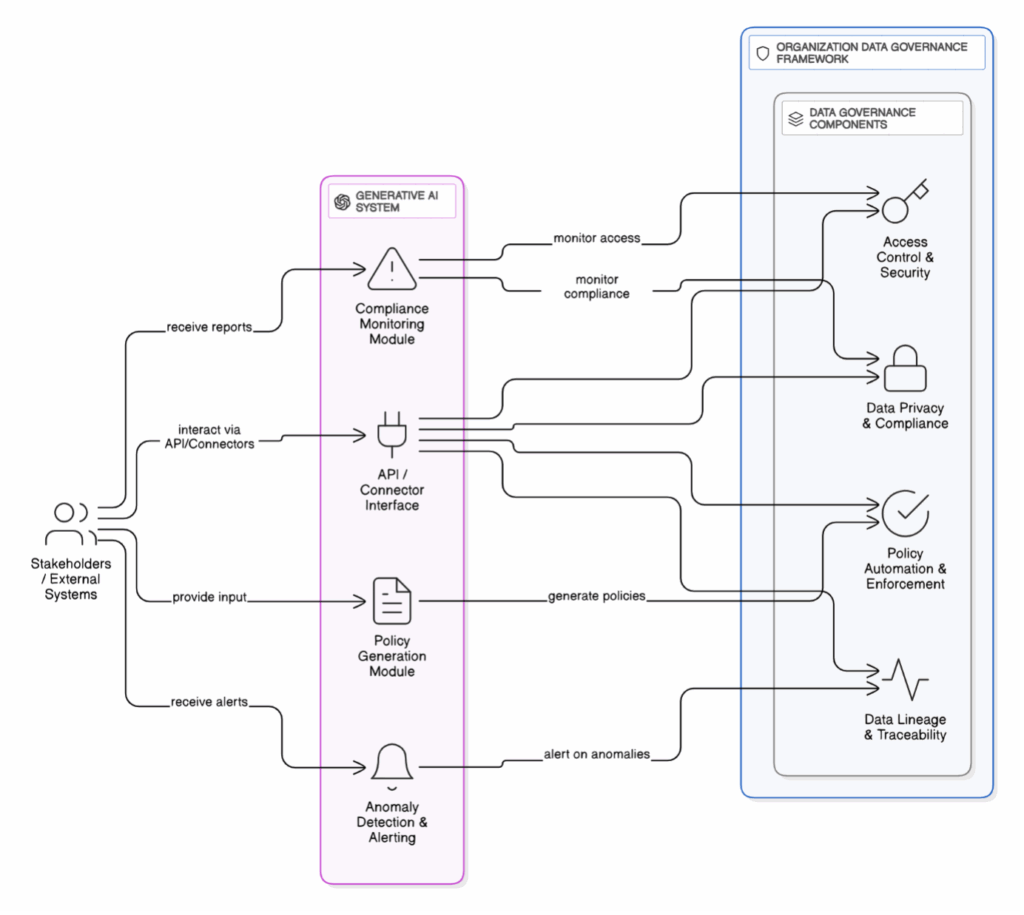
Dr. Magesh Kasthuri
In today’s digital era, data is at the heart of every successful organisation. As data volumes grow and regulations become more stringent, businesses face increasing challenges in managing, securing, and leveraging their information assets. Generative Artificial Intelligence (AI) has emerged as a powerful ally in this landscape, offering innovative solutions to automate, optimise, and reinforce data governance frameworks. This article explores how generative AI—and its intelligent agentic counterparts—can assist organisations in developing robust data governance, with practical examples and best practices tailored for business leaders and data professionals.
Generative AI for Data Governance
Data governance encompasses the policies, processes, and standards that ensure data is accurate, accessible, and secure throughout its lifecycle. Traditionally, establishing and maintaining these controls required significant manual effort. Generative AI changes this paradigm by automating policy creation, monitoring, and enforcement.
For instance, generative AI models can analyse existing data policies and organisational requirements to automatically draft new governance documents. These models can flag inconsistencies, suggest updates based on emerging regulations, and even simulate policy impacts before implementation. Imagine an AI system that reviews your data retention guidelines, compares them with the latest legal mandates, and generates an updated policy draft—saving time and reducing the risk of non-compliance.

Figure: AI infused Data Governance design strategy
AI-driven monitoring tools also continuously scan data usage patterns, automatically alerting stakeholders to anomalies or policy breaches. By learning from historical incidents, these systems can proactively recommend preventive actions, ensuring that governance is not just reactive but adaptive and forward-looking.
Enhancing Data Management with AI
Effective data management underpins strong governance. Generative AI brings remarkable efficiency to tasks like data cataloguing, classification, and quality assurance. By leveraging natural language processing and pattern recognition, AI can scan vast data repositories, automatically tagging and categorising assets based on content and context.
For example, an AI agent might crawl through an organisation’s shared drives, identifying sensitive information such as personal identifiers or financial records, and classifying them accordingly. It can then recommend access controls or data masking to protect privacy. Additionally, generative AI can automate data quality checks—spotting duplicates, detecting anomalies, and suggesting corrections—thereby maintaining data integrity with minimal human intervention.
Automating Data Lineage
Understanding the journey of data—where it originates, how it transforms, and who accesses it—is critical for both governance and compliance. Generative AI excels at mapping data lineage by automatically tracing data flows across systems, applications, and processes.
Consider a scenario where an organisation needs to demonstrate how customer information moves from collection to storage and reporting. AI-powered lineage tools can generate visual maps showing every touchpoint, transformation, and user interaction. This automation not only accelerates audits and compliance reporting but also provides actionable insights to improve data handling practices.
Implementing Security, Compliance, and Guardrails
Security and compliance are non-negotiable in the age of data-driven business. Generative and agentic AI solutions play a pivotal role in establishing robust guardrails—automated controls that enforce security policies and regulatory requirements.
AI can dynamically assess access requests, verifying user credentials, and context before granting permissions. If unusual activity is detected, such as an employee downloading large volumes of confidential data outside business hours, AI-driven systems can trigger alerts or automatically restrict access. Compliance checks are similarly streamlined, with AI continually monitoring data usage against legal frameworks like the GDPR or India’s Personal Data Protection Bill, and flagging potential violations for immediate action.
Agentic AI goes a step further by autonomously remediating issues—revoking privileges, encrypting data, or updating audit logs—reducing the need for manual oversight and accelerating incident response.
Centralised vs Autonomous Data Management: The AI Advantage
Organisations often grapple with choosing between centralised and autonomous (decentralised) data management models. Centralised approaches offer uniformity and control, while autonomous models empower individual teams with flexibility.
Generative AI supports both paradigms. In centralised settings, AI enforces global policies, ensures consistency, and manages data assets from a single point of control. In autonomous environments, AI agents can be embedded within business units, tailoring governance and security measures to local needs while maintaining alignment with overarching standards. This hybrid capability ensures organisations remain agile without compromising data integrity or compliance.
A significant benefit here is cost efficiency. By automating repetitive and complex governance tasks, AI reduces manual labour, minimises errors, and shortens response times. Whether scaling up in a centralised model or empowering autonomous teams, AI-driven solutions optimise resource allocation and drive operational savings.
Cost Efficiency Through AI-Driven Automation
Cost efficiency is a major incentive for embracing generative AI in data governance. Manual policy drafting, data audits, and compliance checks demand considerable time and expertise. AI automates these processes, freeing up skilled professionals to focus on strategic initiatives.
Moreover, AI’s ability to detect and correct errors early prevents costly data breaches, regulatory fines, and reputational damage. For example, automated lineage mapping and real-time monitoring help organisations avoid compliance pitfalls that might otherwise go unnoticed until audits or incidents occur. Over time, the return on investment from reduced operational costs and enhanced risk management can be substantial.
Best Practices for Integrating Generative AI into Data Governance
Depending on the organization data usage patterns, we can design an Data governance practice through a Center of Excellence (CoE) or Data governance board. Here are some of the best practices to implement Data governance through AI infusion strategies.
- Start with Clear Objectives: Define what you aim to achieve—be it regulatory compliance, data quality, or operational efficiency.
- Engage Stakeholders: Involve legal, IT, and business teams in designing AI-assisted governance frameworks to ensure alignment with organisational goals.
- Invest in Data Quality: Ensure that the data feeding your AI models is accurate, complete, and up to date.
- Prioritise Security and Privacy: Implement robust controls to safeguard sensitive information and maintain user trust.
- Monitor and Update Continuously: AI models and governance policies should evolve with changing business needs and regulatory landscapes.
- Foster a Culture of Responsible AI: Educate staff about AI capabilities, limitations, and ethical considerations.
Conclusion
Generative AI is revolutionising data governance by automating critical processes, enhancing security, and driving cost efficiencies. Its ability to adapt to both centralised and autonomous data management models makes it an invaluable asset for organisations seeking to navigate the complexities of modern data landscapes. By following best practices and embracing AI-driven solutions, business leaders and data professionals can build resilient, future-ready governance frameworks that unlock the full potential of their data—securely, compliantly, and efficiently.
